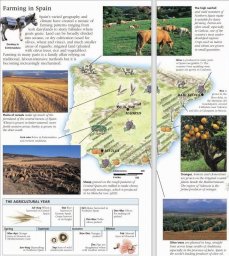Farming in Spain
Spain’s varied geography and climate have created a mosaic of farming patterns ranging from lush dairylands to stony hillsides where goats graze. Land can be broadly divided into secano, or dry cultivation (used for olives, wheat and vines), and much smaller areas of regadío, irrigated land (planted with citrus trees, rice and vegetables). Farming in many parts is a family affair relying on traditional, labour-intensive methods but it is becoming increasingly mechanized.
Plains of cereals make up much of the farmland of the central meseta of Spain. Wheat is grown in better-watered, more fertile western areas; barley is grown in the drier south.
Sheep grazed on the rough pastures of Central Spain are milked to make cheese, especially manchego, which is produced in La Mancha.
Cork oaks thrive in Extremadura and western Andalusia.
The high rainfall and mild summers of Northern Spain make it suitable for dairy farming. Farms are often small, especially in Galicia, one of the country’s most underdeveloped regions. Crops such as maize and wheat are grown in small quantities.
Wine is produced in many parts of Spain. The country’s best sparkling wine grapes are grown in Catalonia.
Rice is grown in the Ebro delta, in the Marismas del Guadalquivir, around L’Albufera near Valencia and also at Calasparra in Murcia.
Oranges, lemons and clementines are grown on the irrigated coastal plains beside the Mediterranean. The region of Valencia is the prime producer of oranges.
Olive trees are planted in long, straight lines across large swaths of Andalusia, especially in the province of Jaén. Spain is the world’s leading producer of olive oil.
Donkey in Extremadura
CROPS FROM TREES
The almond, orange and olive create the three most characteristic landscapes of rural Spain but several other trees provide important crops. Wine corks are made from the bark of the cork oak. Tropical species, such as avocado and cherimoya, a delicious creamy fruit little known outside Spain, have been introduced to the so-called Costa Tropical of Andalusia (see p483); and bananas are a major crop of the Canary Islands. Elsewhere, peaches and loquats are also grown commercially. Figs and carobs – whose fruit is used for fodder and as a substitute for chocolate – grow semi-wild.
Cork oaks are stripped of their bark every ten years
Almonds grow on dry hillsides in many parts of Spain. The spring blossom can be spectacular. The nut, enclosed by a fleshy green skin, is used in a variety of sweetmeats including the Christmas treat turrón.
Olive trees grow slowly and often live to a great age. The fruit is harvested in winter and either pickled in brine for eating as a to extract the oil which is widely used in Spanish cuisine.
Sweet oranges are grown in dense, well-irrigated groves near the frost-free coasts. The sweet smell of orange blossom in springtime is unmistakeable. Trees of the bitter orange are often planted for shade and decoration in parks and gardens.
THE AGRICULTURAL YEAR
Spring
Mar–Apr Orange trees in blossom on Mediterranean coast
Summer
Jun–Aug Haymaking in Northern Spain
Jul–Aug Wheat harvested in Central Spain
Autumn
Sep Rice harvest in Eastern Spain. Grape harvest at its height
Sep Start of wild mushroom season
Oct Maize harvested in Northern Spain
Oct–Nov Table olives picked
Nov–Dec Oranges picked
Winter
Dec Pigs are slaughtered when cold weather arrives
Dec–Mar Olives for making oil picked
Feb Almond trees in blossom
